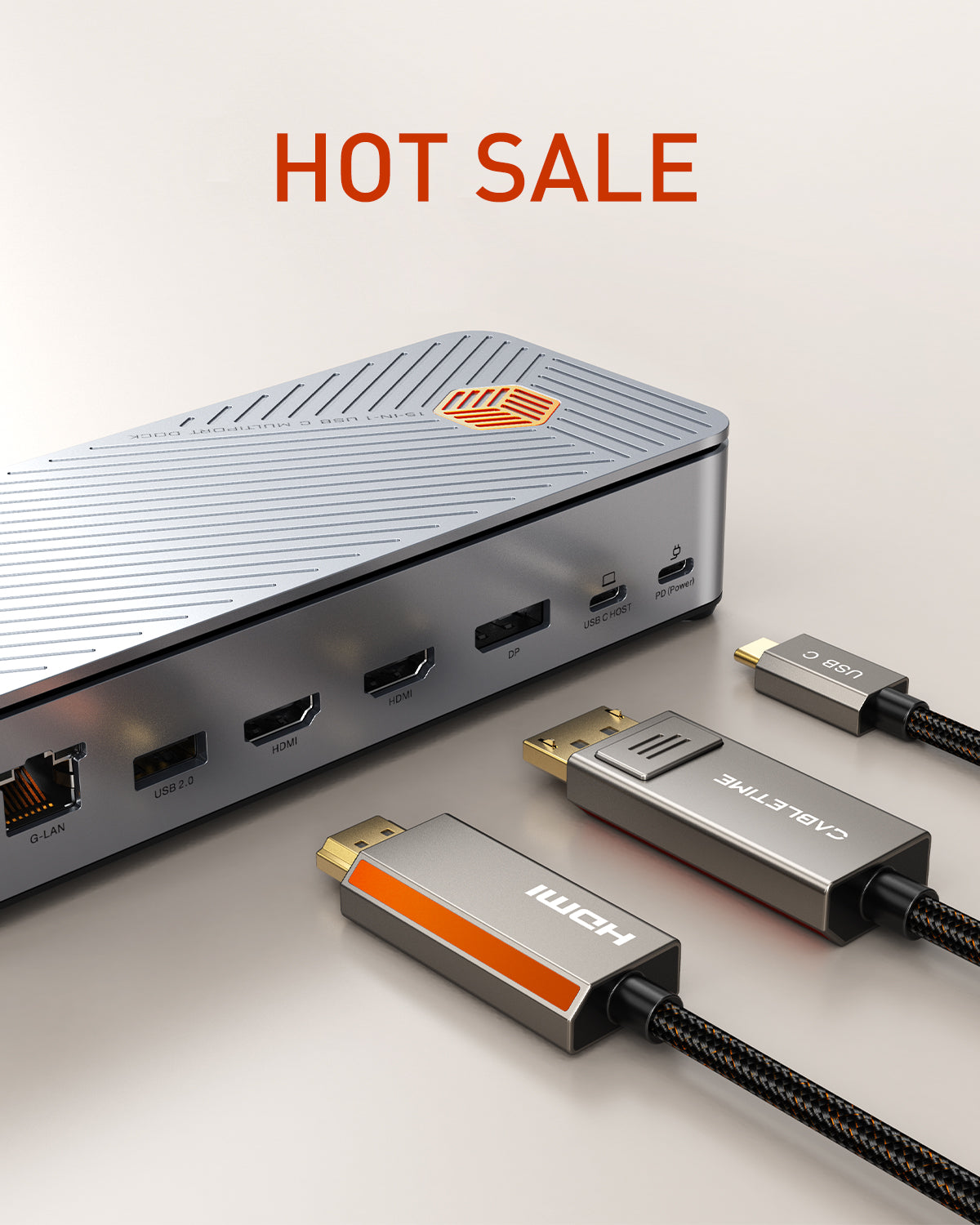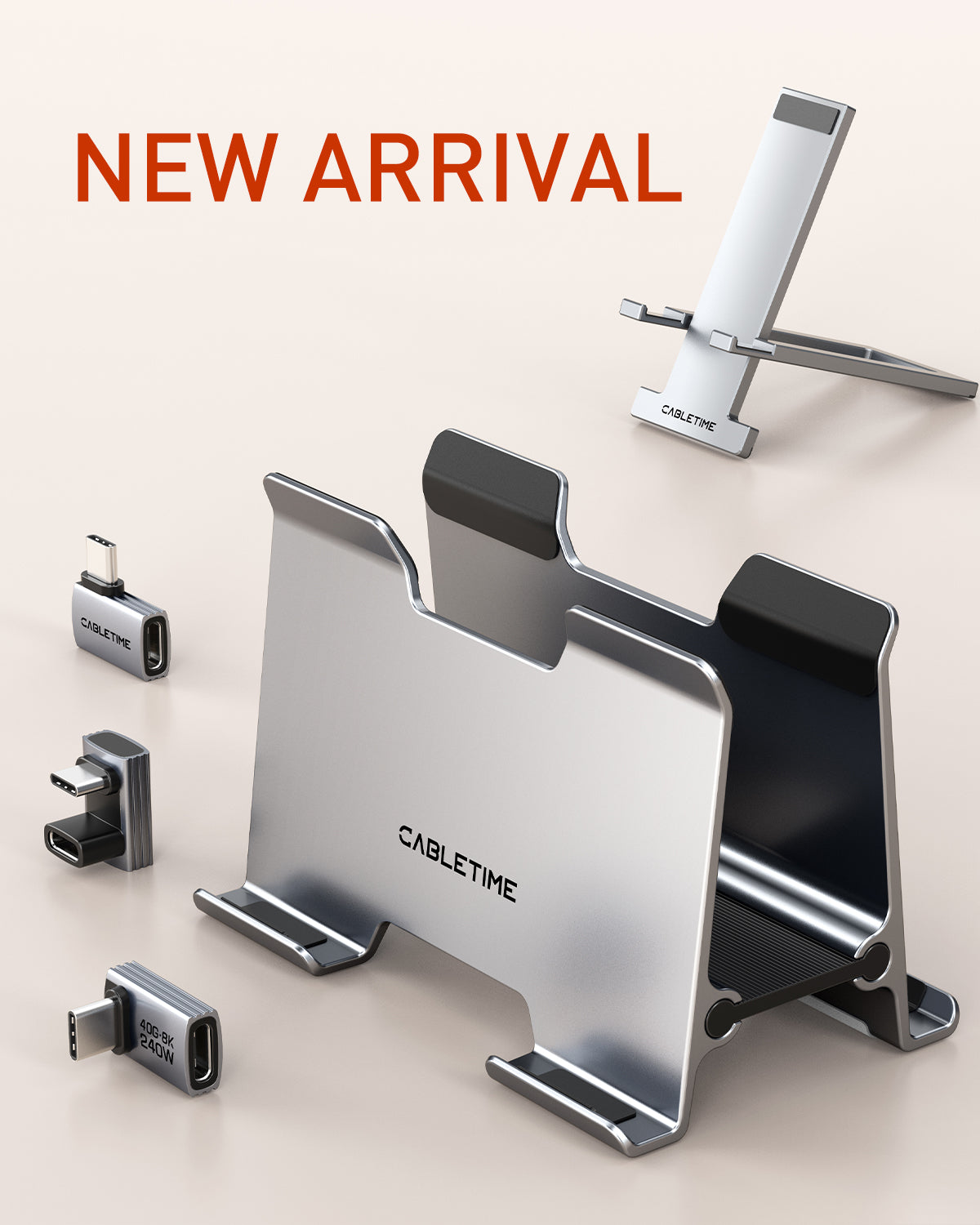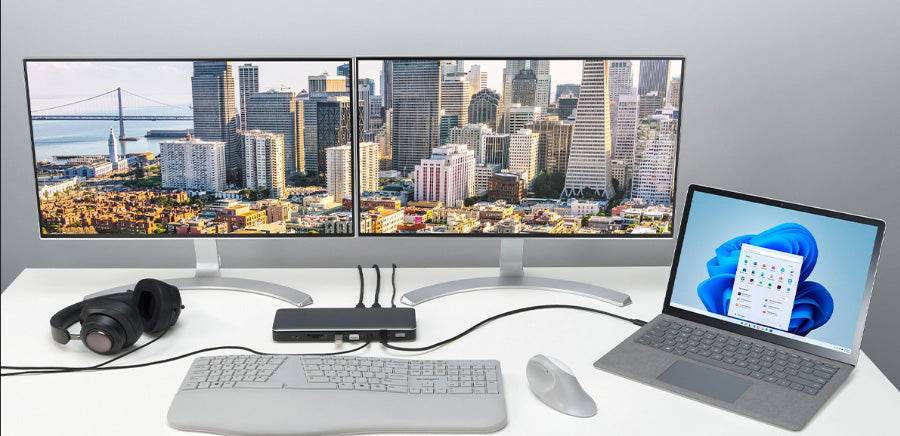Immagina questo! Sei finalmente carico di caffeina e sistemato sulla tua sedia per lavorare, ma il tuo mouse e il tuo telefono hanno bisogno di essere ricaricati. Il tuo cavo di ricarica è scomparso nel disordine e la ciabatta è lontana dalla vista. Ti suona familiare? Se ti trovi in un pasticcio simile, questa guida è per te.
Mantenere il tuo ufficio o la tua casa ben organizzati è fondamentale per mantenere una mente lucida e concentrare l'energia su azioni produttive. Pertanto, investire nella gestione di cavi e accessori diventa un investimento una tantum che ti ricompensa continuamente con una mente lucida e una produttività ottimizzata.
Gadget come smartphone, auricolari, smartwatch, ecc., richiedono tutti attrezzature specifiche e cavi pertinenti per la ricarica e la connettività. Sfortunatamente, tutti questi cavi possono facilmente aggrovigliarsi in una borsa o su un tavolo. Pertanto, abbiamo bisogno di soluzioni innovative, semplici e gestibili per garantire un'organizzazione dei cavi sistematica e senza ingombri. Può comportare fascette, docking station, hub, adattatorie altri prodotti. Questa guida risolverà tutti i tuoi problemi di gestione dei cavi con una guida semplice e facile da seguire.
Indice dei contenuti
Hai davvero bisogno di organizzare i tuoi cavi?
Secondo un sondaggio di Staples, il 70% dei dipendenti ritiene che il disordine nel proprio spazio di lavoro influisca negativamente sulla produttività. Adottare misure per rimuovere il disordine dai tavoli, in particolare carichi di cavi e accessori, può migliorare le prestazioni sul lavoro. Un sondaggio della National Association of Professional Organizers ha rilevato che l'80% degli intervistati ha dichiarato di sentirsi più calmo e rilassato dopo aver riordinato le proprie case. Questo studio costituisce un'ulteriore prova del desiderio umano innato di ordine.
Ora che le statistiche supportano il nostro sforzo di organizzare i cavi, iniziamo a riordinare!
Identificare dispositivi e cavi
Il primo passo è identificare i tuoi dispositivi e i relativi cavi. Ci saranno cavi di ricarica, dati, alimentazione, video, audio ed ethernet attorno al tuo tavolo da lavoro, alla tua postazione di gioco o allo spazio dei gadget domestici.
1.Identificare i tipi: Osservare i connettori di ciascun cavo per identificarne la tipologia.
2.Classificare: Separare i cavi in base al tipo, identificare il percorso e osservare la lunghezza di ogni cavo. Potremmo dover avvolgere un po' di cavo e fissarlo con fascette in seguito.
3.Cavi video: DisplayPort, HDMI, VGA, DVI-D o RCA sono tutti cavi video. Saranno collegati a uno specifico dispositivo di visualizzazione.

4.Cavi dati: Solitamente per il trasferimento dati sono disponibili USB-A, USB-C, MicroUSB, Lightning o Thunderbolt.
5.Cavi di ricarica: I cavi di ricarica e dati sono fondamentalmente simili. Possono essere USB, Lightning o Thunderbolt.
6.Cavi audio: I cavi audio dedicati possono essere da 3,5 mm, RCA o XLR. Gli utenti li usano per collegare dispositivi come cuffie, altoparlanti, microfoni o apparecchiature audio.

Stima lo spazio disponibile e dai priorità ai dispositivi in base all'utilizzo
Dopo aver sistemato tutti i cavi, il passo successivo è identificare tutti i dispositivi, lo spazio necessario e l'eventuale spazio fisso per la ricarica e il posizionamento.
1.Area di stoccaggio: Trova la tua potenziale stazione di ricarica o area di stoccaggio. Può essere l'angolo del tuo tavolo da lavoro, cassetto o scaffale.
2. Dimensioni del dispositivo: Prendi il tuo metro a nastro! Abbiamo bisogno delle dimensioni di ogni gadget per determinare se è possibile posizionarlo orizzontalmente o impilarlo verticalmente.
3. Frequenza di utilizzo: Dai priorità allo spazio di ricarica in base alla frequenza di utilizzo. La ricarica di uno smartphone può essere più frequente di quella di uno smartwatch.
4. Tempo di ricarica: Determinare le esigenze di accessibilità del dispositivo in base alle esigenze di ricarica rapida e prolungata.
Determinare quali cavi possono essere conservati, scartati o sostituiti
Potrebbero esserci casi in cui trovi più cavi dello stesso tipo in giro. È necessario determinare quali extra scartare o sostituire. Ecco i passaggi che puoi seguire per ridurre il numero di cavi:
1.Caricabatterie: Avere più di un caricabatterie collegato alla tua multipresa può portare a più cavi. Ci sono alcuni metodi attraverso cui gli utenti possono ridurre il numero di caricabatterie. Li menzioneremo nelle sezioni successive.
2. Cavi duplicati: Eliminare tutti i cavi identici, donarli o posizionarli lontano dalla vista.
3. Gadget passati: Alcuni cavi potrebbero essere sconosciuti o compatibili con dispositivi più vecchi. Ad esempio, un cavo micro USB potrebbe essere obsoleto per tutti i tuoi dispositivi, quindi è meglio buttarlo o inviarlo al riciclaggio.
Suggerimenti e strumenti per l'organizzazione dei cavi
Grazie ai siti di e-commerce! Trovare la soluzione fai da te per la gestione dei cavi non è mai stato così facile. Abbiamo alcuni suggerimenti e strumenti per aiutarti a iniziare a organizzare il caos dei cavi:
Guaine per cavi
Se hai più cavi di ricarica che vanno dalla multipresa al tuo spazio di ricarica preferito per i gadget, utilizza una guaina per cavi. Esistono molti tipi di guaine per cavi. Spirali, guaine intrecciate, tubi termoretraibili o alluminio hanno pro e contro.
- Spirale: Sono ideali se si desidera un accesso frequente al cavo o se potrebbe essere necessario sostituire alcuni cavi a breve. I cavi all'interno delle guaine a spirale sono più accessibili.
- Maniche intrecciate: Esteticamente, le guaine intrecciate sono le migliori. Si fondono con l'ambiente e possono ospitare facilmente più cavi. Anche la sostituzione del cavo in una guaina intrecciata è accessibile.
- Tubi termoretraibili: Sono realizzati per una presa salda e potrebbe essere necessario utilizzare una pistola termica per restringerli.I tubi termoretraibili sono la soluzione migliore se vuoi che i cavi aderiscano saldamente tra loro in uno spazio compatto.
- Alluminio: Le guaine in alluminio sono le migliori se hai bisogno di interferenze magnetiche o caratteristiche avanzate come durata e affidabilità. Sono costose e utilizzate in ambienti difficili.
Clip da parete
Se il cavo di alimentazione della tua multipresa è allentato, puoi farlo passare ordinatamente lungo la parete usando delle clip. Tutto ciò di cui avrai bisogno è un martello e delle clip della misura giusta. Determina la misura del cavo che devi far passare attorno alla parete e acquista le clip adatte. Posiziona semplicemente il cavo all'interno della clip e martella il chiodo sulla clip per tenere fermo il cavo.
Organizzatori di cavi
Sebbene tutti i prodotti che mettono in ordine i cavi facciano parte degli organizzatori di cavi, esistono alcuni prodotti dedicati all'organizzazione dei cavi che danno priorità all'estetica:
- Fermacavi adesivi: Questi sono i tipi più popolari di organizzatori di cavi nei moderni luoghi di lavoro e nelle case. Impediscono ai cavi di scivolare dalla superficie del tavolo, oppure gli utenti possono posizionarli sotto o sul lato del tavolo per un facile accesso a tutti i cavi. Sono economici e offrono un'estetica ordinata.
- Fascette: Possono essere di plastica, strisce di velcro o fili. Tutti hanno uno scopo semplice: legare insieme i cavi. Gli utenti possono tenere i cavi a distanze specifiche per farli apparire ordinati.
- Vassoi per la gestione dei cavi: Se i cavi passano sopra la scrivania o sul pavimento, basta montare una canalina sotto il tavolo. Fai passare tutti i cavi all'interno della canalina, lontano dalla vista.
Stazioni di ricarica e dispositivi
Ci sono un sacco di dispositivi di ricarica che omogeneizzano il modo in cui carichiamo i dispositivi. Un singolo caricabatterie può caricare fino a 4 dispositivi contemporaneamente. Ecco alcuni dei prodotti più popolari:
- Scatole di gestione dei cavi: Queste scatole possono fungere da stazioni di ricarica. Sono esteticamente gradevoli e possono ospitare una multipresa, caricabatterie e cavi all'interno di un piccolo contenitore.
- Caricabatterie: Alcuni caricabatterie supportano la ricarica di più dispositivi con interfacce a più porte. Sono ideali per ridurre il numero di caricabatterie collegati all'alimentazione, riducendo di conseguenza il numero di cavi.
Sistema di etichettatura dei cavi
Creare un pratico sistema di etichettatura è l'ideale per gli utenti con diversi tipi di cavi che passano lungo il loro spazio di lavoro o la loro casa. L'etichettatura dei cavi li rende più facili da identificare, sostituire o scartare.
Pareti e mobili
Alcune case hanno sistemi di cavi nascosti e prese di corrente avanzate per ridurre la necessità di prese. I progettisti di case li posizionano in modo intelligente nei punti in cui gli utenti potrebbero averne più bisogno.
- Presa di corrente: La più recente tecnologia di dispositivi di ricarica e alimentazione utilizza prese a muro con porte di ricarica USB-C standard. Riducono la necessità di collegare i caricabatterie alle prese di corrente. Pertanto, puoi tenere il caricabatterie da viaggio nella borsa.
- Parete: Le case che utilizzano pannelli in legno possono usare lo spazio dietro di loro per far passare i cavi. Ciò può mantenere l'aspetto della casa in ordine. Anche i pannelli estetici per la sola scrivania sono adatti per far passare i cavi.
- Mobilia: Utilizzare vassoi e rastrelliere nascoste sotto o dietro i mobili, lontano dalla vista, è un modo ideale per mantenere in ordine la casa o il posto di lavoro.
Ricarica wireless: un'alternativa senza cavi
La ricarica wireless sta prendendo piede e i prodotti stanno diventando accessibili.Smartphone, tablet, laptop, auricolari e altri gadget sono dotati di funzionalità di ricarica wireless per un'esperienza senza ingombri.
Ricarica wireless e il suo impatto sull'organizzazione dei cavi
Avere un ambiente ordinato rende i luoghi di lavoro e le case ben organizzati. La ricarica wireless elimina completamente la necessità di gestire più cavi di ricarica e caricabatterie.
- Piani dei tavoli puliti: Le stazioni di ricarica wireless possono gestire più dispositivi contemporaneamente. Non c'è bisogno di collegare e scollegare il cavo. Le stazioni di ricarica moderne sono dotate di funzionalità 3 in 1, caricando tre dispositivi contemporaneamente.
- Adatto ai viaggi: I caricabatterie che funzionano in modalità wireless sono solitamente pieghevoli. Passare da grandi alimentatori e cavi aggrovigliati rende la ricarica wireless interessante.
- Facile accesso: A differenza dei caricabatterie a filo, i caricabatterie wireless sono facili da raggiungere. Non si aggrovigliano e impediscono che altri oggetti nella borsa si danneggino.
Pro e contro della ricarica wireless
I vantaggi della ricarica wireless non si limitano solo allo stoccaggio e al viaggio:
- Sicurezza: Che si tratti del dispositivo o dell'utente, la ricarica wireless protegge entrambi. C'è una minore possibilità di ricevere una scossa elettrica a causa del minor contatto con i cavi. Le possibilità di inciampare nei cavi o di danneggiare il dispositivo sono ridotte drasticamente con la tecnologia wireless.
- Durata: Il prodotto dura solitamente più a lungo degli alimentatori tradizionali perché si collega e scollega meno spesso.
- Stile di vita intelligente: Che si tratti della tua auto, della scrivania, del tavolino o di qualsiasi altro spazio in cui pensi di appoggiare i tuoi gadget, i caricabatterie wireless possono caricare i dispositivi senza problemi.
Personalizzazione della configurazione di ricarica
Poiché il numero di dispositivi che necessitano di ricarica aumenta ogni giorno, sta emergendo la necessità di soluzioni uniche e innovative. Per ridurre la necessità di più stazioni di ricarica e i rifiuti elettronici associati, produttori e organizzazioni governative hanno ideato le seguenti soluzioni:
Standardizzazione dei caricabatterie
L'aumento dei rifiuti elettronici associati a caricabatterie e cavi abbandonati ha portato a una spinta normativa da parte del governo per introdurre una soluzione di ricarica universale. Apple ha recentemente adottato l'interfaccia Type-C per alcuni dei suoi dispositivi a causa della tendenza del mercato, della flessibilità dell'utente e della protezione per il futuro. Ecco alcuni dei nostri suggerimenti che possono ridurre l'ingombro dei cavi e aiutare l'ambiente con un caricabatterie standard Type-C:
- Caricabatterie certificato USB-IF: Acquista un caricabatterie USB-C certificato USB-IF, compatibile con vari dispositivi e con tensione/ampere standard.
- Centrale elettrica per tutti i dispositivi: Un cavo USB-C può fornire 240 W a vari dispositivi.
- Versatilità dell'USB-C: Un singolo USB-C può fornire alimentazione, video/audio e trasferimento dati.
Utilizzare adattatori per cavi

Ti sei finalmente liberato di tutti i caricabatterie e hai un caricabatterie universale per tutte le tue esigenze di ricarica. Ma c'è ancora un problema con i diversi cavi. Alcuni dispositivi si caricano con micro USB, mentre altri usano la porta Type-C, USB-A o Lightning. Ecco perché hai bisogno adattatori per caviTuttavia, è necessario prestare attenzione quando si seleziona un adattatore:
- Presa e spina: Assicurati di avere i lati della presa e della spina corretti. Acquista un adattatore Micro-USB maschio a USB-C femmina per convertire il tuo connettore USB-C in un MicroUSB.
- Qualità: Acquista sempre un adattatore di alta qualità.Alcuni dispositivi assorbono molta energia, il che può danneggiare l'adattatore.
Hub di ricarica e stazione di docking
Una delle migliori soluzioni possibili per la quantità crescente di cavi e il groviglio di cavi è l'utilizzo di una docking station. L'introduzione di connettori USB-C versatili ha aperto nuovi orizzonti per designer e produttori. Ecco le caratteristiche salienti di una docking station e il loro impatto sulla gestione dei cavi:
- Cavo singolo: Una connessione USB-C a una singola porta di un laptop o di un computer collega la docking station a numerose opzioni di connettività.
- Diversità: Fornisce varie connessioni via cavo, tra cui dati, alimentazione, audio, video e connettività Ethernet.
- Gestione pratica dei cavi: In questo modo si riduce la necessità di instradare più cavi dalla sorgente, rendendo la gestione dei cavi più accessibile e comoda.
Costruire il tuo dock di ricarica
Vuoi costruire il tuo dock di ricarica su misura per le tue esigenze? Abbiamo un'eccellente guida passo-passo per creare un dock di ricarica personalizzato. Cominciamo!
1.Concettualizzare il Dock: Immagina la forma del dock che desideri. Dai un'occhiata alla configurazione in cui vuoi che si fonda. Utilizza gli algoritmi già stabiliti per assicurarti che il tuo nuovo dispositivo si adatti perfettamente. Vai al tavolo da disegno e disegna uno schizzo.
2.Definisci i tuoi requisiti: A seconda dei metodi scelti, hub USB, caricabatterie multiporta o pad di ricarica wireless. Acquista i dispositivi pertinenti e prendi in considerazione soluzioni di gestione dei cavi come guaine o clip.
3. Pianifica il materiale e gli strumenti: Vuoi una base di ricarica in legno, plastica, metallo o cartone? Assicurati di avere l'attrezzatura necessaria in base al materiale che hai scelto, come trapani, seghe, carta vetrata, colla a caldo e taglierini.
4.Inizia la costruzione: Dopo aver finalizzato il design, le porte, gli hub di ricarica e i pad di ricarica wireless. Inizia il processo di taglio, foratura, fissaggio, serraggio e finitura. Utilizza un adesivo come la colla a caldo per tenere insieme i fili all'interno del dock.
Ecco alcuni esempi di configurazioni di ricarica personalizzate per trarre ispirazione:
Esempio n. 1: Woodsy Haven

Un rifugio boschivo per i nomadi della tecnologia. Questa stazione artigianale ospita telefoni, AirPods e Apple Watch in modo ben organizzato. Di' addio al caos dei cavi e dai il benvenuto alla ricarica ibrida via cavo e Zen. Usa semplicemente una docking station e un hub per alimentare tutti questi dispositivi contemporaneamente.
Esempio n. 2: Potenza di disegno

Questo cassetto riadattato e trasformato in un rifugio tecnologico nasconde abilmente un nido di gadget. I telefoni riposano all'interno del cassetto, i cavi passano attraverso canali nascosti e un pad wireless rende la ricarica un posto e un ricordo. Non c'è più confusione sul tavolo, solo serenità elegante e scorrevole. Un semplice hub di ricarica o un caricabatterie multiporta sono sufficienti per alimentare tutti i tuoi dispositivi contemporaneamente. Installa un pad di ricarica sotto la base del cassetto per ulteriore semplicità.
Esempio n. 3: Rack in rete metallica

Questa ingegnosa creazione trasforma un semplice supporto da parete in "rete metallica" in una stazione di ricarica multi-dispositivo. I tablet trovano un posizionamento sicuro sui loro robusti ripiani, mentre le cuffie pendono con grazia da ganci designati. Un hub di ricarica discretamente integrato elimina l'ingombro dei cavi, favorendo un ambiente di organizzazione semplificata e gestione efficiente dell'alimentazione.
Il ruolo della gestione dei cavi nelle case intelligenti
Da Grovigli a Sinfonia Tecnologica: L'organizzazione intelligente dei cavi non riguarda più solo il loro aspetto. I caricabatterie wireless alimentano i dispositivi senza problemi e i dispositivi a molla riavvolgono delicatamente i cavi allentati. Le prese intelligenti disattivano automaticamente l'alimentazione per eliminare gli scarichi fantasma e i sensori avviano la ricarica in base a orari o vicinanza. Il risultato? Un luogo senza confusione in cui l'energia scorre senza problemi e si adatta alla tua vita digitale.
Futuro sopra e oltre i fili: La ricarica wireless è la strada del futuro, ma è anche inaspettata. Immagina mobili con stazioni di ricarica integrate, strade che caricano le auto elettriche mentre sono in movimento o tessuti intrecciati con fili conduttivi. Niente più spine! Calore, movimento, energia ambientale e altre fonti sono pronte a rivoluzionare la ricarica.
Conclusione
Per riassumere la guida completa, possiamo riepilogare le strategie chiave per organizzare i cavi di ricarica e gli accessori.
- Utilizza clip, fascette, vassoi, organizer, mobili e stazioni di ricarica per liberare il tuo posto di lavoro o la tua casa dai cavi.
- Opta per la ricarica wireless perché è la strada per il futuro. Esplora le opzioni after-market per ogni dispositivo personale per abilitare le loro capacità di ricarica wireless.
- Utilizzare un caricabatterie certificato, standardizzato e versatile, come il caricabatterie USB-C.
- Esplora le opzioni disponibili negli hub di ricarica e nelle docking station per un ambiente privo di cavi.
- Utilizza un adattatore per cavo con un caricabatterie universale per utilizzare un unico cavo per tutte le tue esigenze di ricarica.
- Costruisci una base di ricarica fai da te per la massima personalizzazione.
Oltre a questi suggerimenti, continua sempre a rivedere il tuo sistema di gestione dei cavi. Ci sono nuovi prodotti che possono apportare benefici al tuo posto di lavoro e garantire un approccio minimalista all'estetica. Sii tra l'80% delle persone che hanno riordinato le proprie case sentendosi più calme e rilassate, secondo la National Association of Professional Organizers. Prendere il controllo dei cavi tecnologici può avere un effetto simile, creando un senso di serenità nel tuo spazio di lavoro o di vita.






Commenta
Questo sito è protetto da hCaptcha e applica le Norme sulla privacy e i Termini di servizio di hCaptcha.